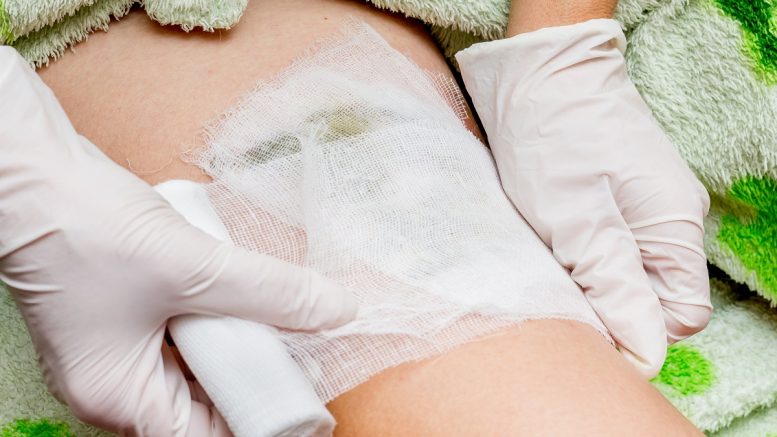Successful healthcare delivery relies on a patient’s ability to adhere to their prescribed treatment. Despite the fast pace of healthcare innovation over the last century, many care pathways remain afflicted by patient non-adherence – particularly for chronic diseases. Adherence to medication for chronic conditions is as low as 50 percent in high-income countries, and lower in poorer areas.
Wound care is no exception; many patients living with chronic wounds, such as venous leg ulcers (VLUs), struggle to adhere to treatment. Hard-to-heal and recurring wounds cause a significant negative impact on a patient’s quality of life and contribute to billions in healthcare costs. In the UK, there have been few improvements over the last 30 years in the levels of adherence to wound care, with leg ulcers costing the NHS almost £2 billion to treat every year.
This was significantly exacerbated by Covid-19 where wound clinics were closed and scaled back to stop the spread of the virus, leaving patients to manage their ulcers independently at home. Tackling adherence to wound care can improve patient outcomes, relieve pressures on healthcare systems and reduce treatment costs.
A silent epidemic
VLUs are the most prevalent type of leg ulcer, making up approximately 90 percent of all cases and affecting one in 500 adults in the UK. Although VLUs typically heal within three to four months, some take years while others never heal at all. Recurrence is also common, affecting up to 70 percent of patients and leaving many suffering with VLUs on an ongoing basis, requiring frequent care from wound specialists.
The current standard of care for VLU treatment recommends compression therapy, involving medically prescribed compression bandaging or stockings applied by a clinically trained wound specialist. This reduces vein distension, activating the calf muscles to pump blood back to the heart and reduce oedema. Compression bandaging comes in various forms, including two- and four-layer, hosiery and wraps and will depend on what is required for optimal healing as well as the patients’ preferences for comfort.
However, it is estimated that adherence to VLU standard of care ranges between 12 and 52 percent, indicating that many patients are unable to reap the benefits of treatment.
Identifying the causes
There are many factors that affect adherence and make healing extremely difficult. A study by Weller et al (2021) highlighted the most common contributors to non-adherence, including: compression-related body image issues; lack of patient understanding of their treatment plan and the consequences of non-adherence; and cognitive issues limiting the ability of patients to understand and implement self-care instructions, amongst others.
Adherence to treatment is therefore multidimensional and impacted by various demographic, socio-economic, financial, and climatic factors. Like other chronic conditions, wound care requires patients to play a vital role in their own recovery. Without the right environment and support, patients will struggle to adequately treat their wounds – as was largely the case during Covid-19.
Treatment insights: a case study
A recent insights survey conducted by Sky Medical Technology explored the emotional impact of VLUs, adherence to standard of care (compression therapy), and alterations in the level of care as a result of the pandemic.
Using qualitative insight from vascular surgeons, tissue viability nurses (TVNs), community nurses (CNs), and VLU patients across the UK, the survey was able to examine the impact of Covid-19 on wound care delivery, the current extent and success of self-care, and any barriers that exist to introducing MedTech innovation into the healthcare network.
Common themes and findings
- Health delivery during Covid-19
A stand-out finding, in context to the pandemic, was the re-deployment of wound specialists, such as TVNs, to the hospital setting to support the delivery of Covid-19 critical care. Whilst completely understandable, this refocus of a critical resource was to the detriment of wound patients suffering with acute and chronic conditions.
Most wound clinics were also suspended. All CNs reported the rapid creation of materials to support patient self-care, in the home setting – with most utilizing materials created by the National Wound Care Strategy Programme (NWCSP) in written and video format to help instruct patients on how to wash legs, care for wounds and apply compression correctly. Importantly, all CNs agreed that embracing VLU self-care is needed in the future – especially with many wound care professionals leaving the health service.
- Telemedicine
With fewer face-to-face visits, all CNs also reported some use of telephone triage but felt it to be less effective, particularly for patients who struggle with phone/internet access, internet literacy or have cognitive impairments. All CNs were open minded to the role of tele-triage but expressed a common concern that self-care and/or shared care first requires a holistic assessment and the development of a care plan that both a patient and carer can adhere to. Particularly as many patients find the correct level of compression hard to tolerate – causing low adherence to standard of care.
- Healthcare resources
All TVNs interviewed expressed the concern that generalists within the community nurse teams, prior, during and since Covid-19, are continuously asked to work with fewer resources. Vacant posts are currently unfilled and however good-willed the generalists are, there comes a time where they struggle to find the time to dress wounds as part of ‘basic nursing care’.
Wound care is increasingly delegated to Healthcare Assistants within primary care and the role of the TVN is in educating and training colleagues, as well as supporting generalists in recognising their accountability. They also expressed the need to address comorbidities, such as obesity management and exercise with patient healthcare coaching.
- Embracing innovation
Vascular surgeons expressed not having a positive perception of the standard of wound care in the community, in respect to timely expertise to diagnose and refer leg ulcer patients to vascular teams. On the question of championing MedTech innovation to improve VLU healing, the majority expressed they are motivated to embrace innovation but would require robust clinical evidence. Many also highlighted the lack of a robust framework between secondary and primary care to achieve full adoption within local networks.
- Emotional impact
Unsurprisingly, all patients reported experiencing pain, discomfort, social isolation, malodour, exudate leakage, and reduced mobility – expressing that VLUs stop them living their lives and robs them of hope. Those with long-term unhealed VLUs also expressed feelings of anger, denial, guilt, aggression, depression, grief, anxiety and worthlessness.
The way forward
The pandemic necessitated delivering care differently, and many services rose to the challenge. Many more patients have been supported to self-care, requiring fewer face-to-face visits. Having lifted the barriers to support self-care and telemedicine, it is also recognised that these modes of care delivery will not suit all patients. Self-care cannot mean support and good shared-care systems are no longer needed.
There is some evidence that areas that have adapted best are those with well-resourced tissue viability and community care services that are already offering advanced care. However, the need to do things differently has led to a broader cultural shift, with more tele-medicine assessments and consultations and more patients supported to self-care. These changes are likely to endure and grow well after the pandemic and will accelerate the redesign of services.
About the author
Bernard Ross is CEO and founder of Sky Medical Technology (Sky). Sky’s multi-award-winning device – the geko™ device – is a wristwatch-sized wearable applied to the knee delivering painless electrical impulses to stimulate blood flow, without the patient having to move. It has been globally adopted into healthcare systems to treat a range of medical conditions such as the prevention of blood clots.
Bernard is a serial entrepreneur with more than 20 years’ senior experience at private and public board level across multiple industries including pharmaceutical, technology development and FMCG. Bernard is a former Head of International Development at CMI plc, Senior Vice President, Cardiovascular of Bioaccelerate Inc. (BACL) and former CEO of Innacardio Inc.





